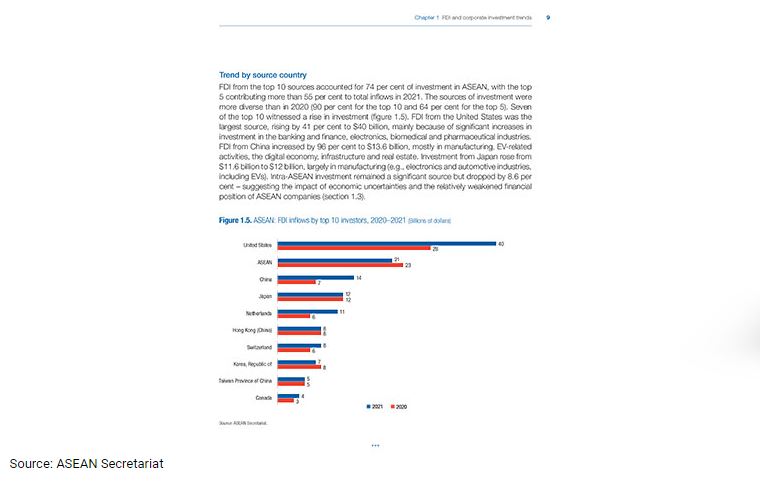Asean records 42% increase in FDI inflow for 2021
Asean countries together received $174 billion as Foreign Direct Investment (FDI) in 2021, a 42 percent rebound compared to the previous year, according to the Asean Investment Report 2022, released by the Asean Secretariat yesterday.
The increase to near pre-pandemic levels reversed the 30 percent decline in 2020 ($122 billion) caused by the Covid-19 outbreak and once again reflected the attractiveness of the region’s economy to global investors, said Asean Secretary-General Dato Lim Jock Hoi.
The inflow of FDI to the region has been increasingly driven by emerging opportunities in sectors such as electric vehicles, electronics, digital economy and green technologies. Startups – in particular the unicorns – have been critical in driving these new trends and contributing to the Industry 4.0 transformation in Asean.
The FDI recovery in Asean compared favourably with the 30 percent average growth in the inflows to developing economies. Six Member States of Asean recorded a rise in inflows and in two, inflows remained flat. This contrasted with the situation in 2020 when only two Member States recorded a rise.
Among the 10-member Asean group, Singapore received the largest chunk of the FDI pie with $99.1 billion, an increase of 31 percent over 2020, followed by Indonesia with $20.1 billion, Vietnam $15.7 billion and Malaysia $11.6 billion.

FDI inflow to Cambodia was, however, flat at $3.5 billion ($3.6 billion in 2020) but it remained high compared with the 2015–2019 annual average of $2.8 billion. Inflows into manufacturing, though, rose by 28 percent to $710 million. FDI in the garment industry – traditionally the largest manufacturing recipient– held steady at $272 million.
FDI from the US to the region constituted the largest share at $40 billion. Next came China with $14 billion, a 96 percent rise, that mostly went to manufacturing, EV-related activities, digital economy, infrastructure and real estate. Investment from Japan rose marginally to $12 billion, largely in manufacturing such as electronics and automotive industries including EVs.
Intra-Asean investment, however, fell by $2 billion, or nine percent, though the inflows remained at a high level of $21 billion. Intra-Asean investment remained a significant source, second only after the US.
“As we continue to be confronted by global economic uncertainties, brought about by factors such as the evolving pandemic, supply chain disruptions, inflationary pressures and geo-political conflicts, it is more important than ever that Asean remains steadfast in its economic integration and create a conducive climate for business and investment,” said Dato Lim Jock Hoi.
According to the report, several factors have led to the robust upturn of FDI inflow in the region. They included rising investment across different modalities, a strong rebound in manufacturing, corporate investment strategies focusing on capacity expansion to bolster supply chains and for the post-pandemic recovery, significant investment from key source countries and investment in infrastructure-related activities, including in the digital economy.
A broad-based rise in FDI in manufacturing played a key role in 2021. Strong investment in manufacturing, finance and some services industries associated with the rapidly growing digital economy and Industry 4.0 activities were the main industry drivers.
Investment in manufacturing recorded the strongest growth (134 percent), to $45 billion, contributed mainly by electric vehicles (EVs), electronics, biomedical and pharmaceuticals.
Source: https://www.khmertimeskh.com/501150830/asean-records-42-increase-in-fdi-inflow-for-2021/


 English
English




